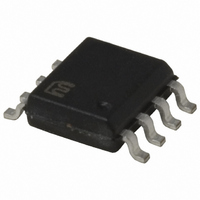MIC4429YM TR Micrel Inc, MIC4429YM TR Datasheet - Page 8

MIC4429YM TR
Manufacturer Part Number
MIC4429YM TR
Description
IC DRIVER MOSFET 6A LS 8-SOIC
Manufacturer
Micrel Inc
Datasheet
1.MIC4420YM_TR.pdf
(12 pages)
Specifications of MIC4429YM TR
Configuration
Low-Side
Input Type
Inverting
Delay Time
18ns
Current - Peak
6A
Number Of Configurations
1
Number Of Outputs
1
Voltage - Supply
4.5 V ~ 18 V
Operating Temperature
-40°C ~ 85°C
Mounting Type
Surface Mount
Package / Case
8-SOIC (3.9mm Width)
Lead Free Status / RoHS Status
Lead free / RoHS Compliant
High Side Voltage - Max (bootstrap)
-
Other names
MIC4429YMTR
MIC4429YMTR
MIC4429YMTR
MIC4420/4429
Input Stage
The input voltage level of the 4429 changes the quiescent
supply current. The N channel MOSFET input stage tran-
sistor drives a 450µA current source load. With a logic “1”
input, the maximum quiescent supply current is 450µA.
Logic “0” input level signals reduce quiescent current to
55µA maximum.
The MIC4420/4429 input is designed to provide 300mV of
hysteresis. This provides clean transitions, reduces noise
sensitivity, and minimizes output stage current spiking when
changing states. Input voltage threshold level is approxi-
mately 1.5V, making the device TTL compatible over the
4 .5V to 18V operating supply voltage range. Input current
is less than 10µA over this range.
The MIC4429 can be directly driven by the TL494,
SG1526/1527, SG1524, TSC170, MIC38HC42 and similar
switch mode power supply integrated circuits. By offloading
the power-driving duties to the MIC4420/4429, the power
supply controller can operate at lower dissipation. This can
improve performance and reliability.
The input can be greater than the
current will flow into the input lead. The propagation delay
for T
perature. The input currents can be as high as 30mA p-p
(6.4mA
voltage. No damage will occur to MIC4420/4429 however,
and it will not latch.
The input appears as a 7pF capacitance, and does not
change even if the input is driven from an AC source. Care
should be taken so that the input does not go more than 5
volts below the negative rail.
Power Dissipation
CMOS circuits usually permit the user to ignore power dis-
sipation. Logic families such as 4000 and 74C have outputs
which can only supply a few milliamperes of current, and
even shorting outputs to ground will not force enough cur-
rent to destroy the device. The MIC4420/4429 on the other
hand, can source or sink several amperes and drive large
capacitive loads at high frequency. The package power
dissipation limit can easily be exceeded. Therefore, some
GROUND
GROUND
M9999-072205
POWER
LOGIC
Figure 4. Switching Time Degradation Due to
D2
0 V
RMS
will increase to as much as 400ns at room tem-
5.0V
0.1µF
) with the input, 6 V greater than the supply
300 mV
+18 V
Negative Feedback
MIC4429
1
4
6 AMPS
8
5
6, 7
PC TRACE RESISTANCE = 0.05Ω
WIMA
MKS-2
1 µF
TE K C U R R E N T
0.1µF
P ROB E 6 3 0 2
+
V
S
supply, however,
2,500 pF
P O L Y C A R B O N A T E
18 V
0 V
8
attention should be given to power dissipation when driving
low impedance loads and/or operating at high frequency.
The supply current vs frequency and supply current vs
capacitive load characteristic curves aid in determining
power dissipation calculations. Table 1 lists the maximum
safe operating frequency for several power supply volt-
ages when driving a 2500pF load. More accurate power
dissipation figures can be obtained by summing the three
dissipation sources.
Given the power dissipation in the device, and the thermal
resistance of the package, junction operating temperature
for any ambient is easy to calculate. For example, the
thermal resistance of the 8-pin MSOP package, from the
data sheet, is 250°C/W. In a 25°C ambient, then, using a
maximum junction temperature of 150°C, this package will
dissipate 500mW.
Accurate power dissipation numbers can be obtained by
summing the three sources of power dissipation in the
device:
• Load Power Dissipation (P
• Quiescent power dissipation (P
• Transition power dissipation (P
Calculation of load power dissipation differs depending on
whether the load is capacitive, resistive or inductive.
Resistive Load Power Dissipation
Dissipation caused by a resistive load can be calculated
as:
P
where:
R
Table 1: MIC4429 Maximum
Operating Frequency
Conditions:
D =
L
O
I =
= I
= the output resistance of the driver when the output
2
the current drawn by the load
is high, at the power supply voltage used. (See data
sheet)
fraction of time the load is conducting (duty cycle)
R
18V
15V
10V
O
V
S
D
1. DIP Package (θ
2. T
3. C
A
L
= 25°C
= 2500pF
L
)
Max Frequency
JA
T
Q
= 130°C/W)
)
)
500kHz
700kHz
1.6MHz
Micrel, Inc.
July 2005











